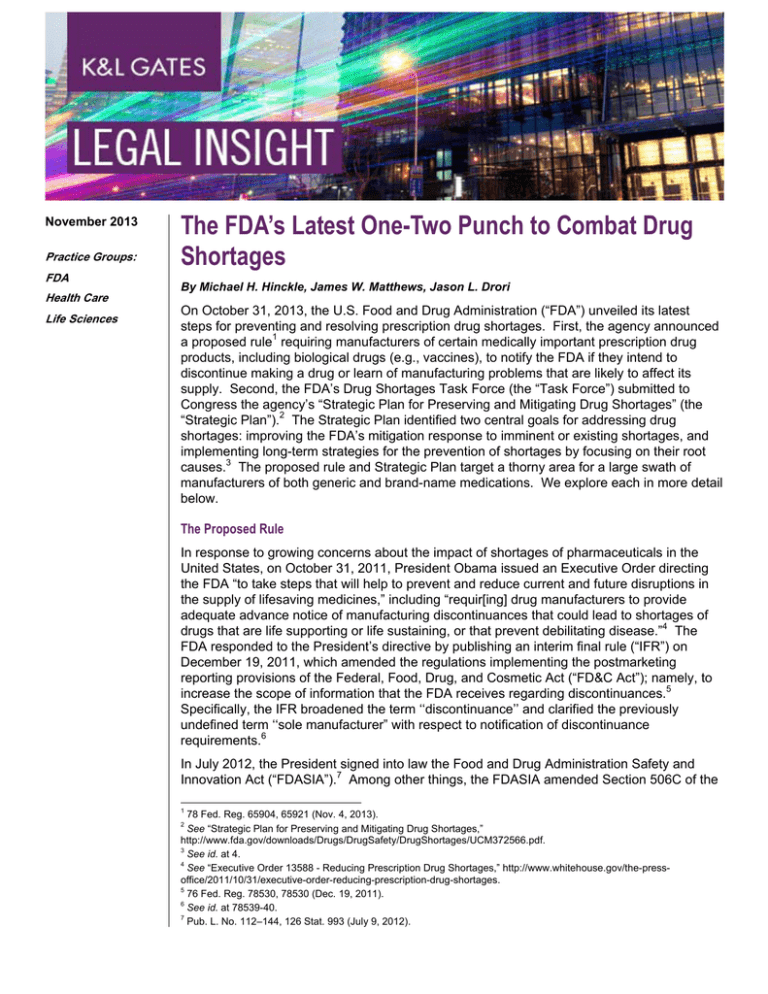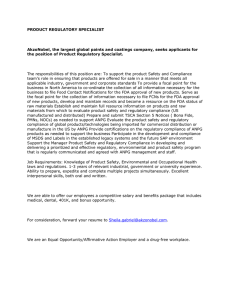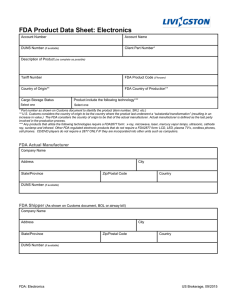
November 2013
Practice Groups:
FDA
The FDA’s Latest One-Two Punch to Combat Drug
Shortages
By Michael H. Hinckle, James W. Matthews, Jason L. Drori
Health Care
Life Sciences
On October 31, 2013, the U.S. Food and Drug Administration (“FDA”) unveiled its latest
steps for preventing and resolving prescription drug shortages. First, the agency announced
a proposed rule1 requiring manufacturers of certain medically important prescription drug
products, including biological drugs (e.g., vaccines), to notify the FDA if they intend to
discontinue making a drug or learn of manufacturing problems that are likely to affect its
supply. Second, the FDA’s Drug Shortages Task Force (the “Task Force”) submitted to
Congress the agency’s “Strategic Plan for Preserving and Mitigating Drug Shortages” (the
“Strategic Plan”).2 The Strategic Plan identified two central goals for addressing drug
shortages: improving the FDA’s mitigation response to imminent or existing shortages, and
implementing long-term strategies for the prevention of shortages by focusing on their root
causes.3 The proposed rule and Strategic Plan target a thorny area for a large swath of
manufacturers of both generic and brand-name medications. We explore each in more detail
below.
The Proposed Rule
In response to growing concerns about the impact of shortages of pharmaceuticals in the
United States, on October 31, 2011, President Obama issued an Executive Order directing
the FDA “to take steps that will help to prevent and reduce current and future disruptions in
the supply of lifesaving medicines,” including “requir[ing] drug manufacturers to provide
adequate advance notice of manufacturing discontinuances that could lead to shortages of
drugs that are life supporting or life sustaining, or that prevent debilitating disease.”4 The
FDA responded to the President’s directive by publishing an interim final rule (“IFR”) on
December 19, 2011, which amended the regulations implementing the postmarketing
reporting provisions of the Federal, Food, Drug, and Cosmetic Act (“FD&C Act”); namely, to
increase the scope of information that the FDA receives regarding discontinuances.5
Specifically, the IFR broadened the term ‘‘discontinuance’’ and clarified the previously
undefined term ‘‘sole manufacturer” with respect to notification of discontinuance
requirements.6
In July 2012, the President signed into law the Food and Drug Administration Safety and
Innovation Act (“FDASIA”).7 Among other things, the FDASIA amended Section 506C of the
1
78 Fed. Reg. 65904, 65921 (Nov. 4, 2013).
See “Strategic Plan for Preserving and Mitigating Drug Shortages,”
http://www.fda.gov/downloads/Drugs/DrugSafety/DrugShortages/UCM372566.pdf.
3
See id. at 4.
4
See “Executive Order 13588 - Reducing Prescription Drug Shortages,” http://www.whitehouse.gov/the-pressoffice/2011/10/31/executive-order-reducing-prescription-drug-shortages.
5
76 Fed. Reg. 78530, 78530 (Dec. 19, 2011).
6
See id. at 78539-40.
7
Pub. L. No. 112–144, 126 Stat. 993 (July 9, 2012).
2
The FDA’s Latest One-Two Punch to Combat Drug
Shortages
FD&C Act to modify the requirements for reporting and addressing permanent
discontinuances or interruptions in the manufacturing of life-saving drug products.8 Now,
with the November 4 proposed rule, the FDA seeks to implement the expanded early
notification requirements in the FDASIA. The rule includes the following definitional and
other substantive changes:
• Requiring any permanent discontinuance or any interruption in manufacturing that is likely
to lead to a “significant” or “meaningful” disruption in the supply of a covered drug or
biological product to be reported to the FDA.9
• Expanding the early notification requirements of Section 506C of the FD&C Act to apply
to all biological products, including plasma-derived products and their recombinant
analogs, vaccines, and in a more limited manner, to blood or blood components.10
8
9
•
Extending the notice requirements of the FD&C Act to all manufacturers of
covered drugs and biological products, not only their “sole manufacturer.”11
•
For the first time, requiring the FDA to issue a public noncompliance letter to a
manufacturer who fails to provide sufficient warning of an impending drug
shortage.12
•
Defining a “life supporting or life sustaining” drug product as one “essential to,
or that yields information that is essential to, the restoration or continuation of
a bodily function important to the continuation of human life.”13
•
Defining the phrase “intended for use in the prevention or treatment of a
debilitating disease or condition” in the FD&C Act, as amended by the
FDASIA, to mean “a drug product intended for use in the prevention or
treatment of a disease or condition associated with mortality or morbidity that
has a substantial impact on day-to-day functioning.”14
21 U.S.C. §§ 356c(a); 356c(b).
See 78 Fed. Reg. 65904, 65914 (2013). Under the rule, a “meaningful disruption” is defined to encompass any
change in production that is reasonably likely to lead to a reduction in
the supply of a drug by a manufacturer that is more than negligible and
affects the ability of the manufacturer to fill orders or meet expected
demand for its product, [but] does not include interruptions in
manufacturing due to matters such as routine maintenance or
insignificant changes in manufacturing so long as the manufacturer
expects to resume operations in a short period of time.
See id. at 65921-22. A “significant disruption” is similarly, but separately, defined with respect to the supply of blood or
blood components. See id.
10
See id. at 65906.
11
Compare 78 Fed. Reg. 65904, 65908 (2013) with 21 C.F.R. 314.81(b)(3)(iii)(a) (requiring notice of discontinuance from
“the sole manufacturer of an approved drug product . . . ”).
12
See 78 Fed. Reg. 65904, 65922 (2013) (“[The] FDA will make the letter and the applicant’s response to the letter public,
unless, after review of the applicant’s response, FDA determines that the applicant had a reasonable basis for not
notifying FDA . . . .”).
13
See id. at 65921.
14
See id.
2
The FDA’s Latest One-Two Punch to Combat Drug
Shortages
The Strategic Plan
The FDASIA directed the FDA to “establish a task force to develop and implement a strategic
plan for enhancing the Secretary’s response to preventing and mitigating drug shortages.”15
The Task Force released its Strategic Plan to deal with drug shortages on October 31.
The Strategic Plan details the FDA’s current efforts to prevent and mitigate drug shortages,
emphasizing the need for early notification of production disruptions from manufacturers.16
To strengthen its mitigation response (i.e., goal #1), the Task Force recommended that the
FDA develop and/or streamline internal processes for managing and tracking data relating to
drug supply shortages and disruptions in production, improve communications with the public
regarding actual or potential shortages, and more closely collaborate with drug
manufacturers and other pharmaceutical industry stakeholders to anticipate and prevent
production problems that can disrupt drug supplies.17
Effective long-term prevention strategies (i.e., goal #2), the Task Force wrote, “must []
recognize the importance of addressing the underlying causes of shortages, including
sustaining manufacturing quality.”18 The Task Force noted that “shortages cannot be
resolved until one or more manufacturers commit to fill in for lost production” and,
accordingly, proposed developing ways for the FDA and industry stakeholders to give “more
positive incentives” to ensuring and prioritizing manufacturing quality.19 Another
recommendation was that drug makers could explore building redundant manufacturing
capacity, holding spare capacity, or increasing inventory levels to lower the risks of
shortages — manufacturing practices the FDA admits it may neither require nor regulate.
Thus, the Task Force told Congress that the FDA cannot legislate away the problem of
shortages but that, practically speaking, “[s]uccess in addressing drug shortages requires a
collective effort by all stakeholders — manufacturers, federal partners, researchers,
professional organizations, and patients.”20
Concluding thoughts
Despite the significant public health threat posed by shortages of drugs and biologics, the
Task Force was forced to confront the reality that typically “cost [is] the major factor in
purchasing decisions,” not the ability of manufacturers to offer innovative manufacturing
processes and technologies:
Within the limits set by disclosure law, FDA makes certain information
publicly available about the historical ability of manufacturers to produce
quality products. . . . Nevertheless, numerous comments to the Federal
Register notice suggested that buyers (e.g., hospitals, health maintenance
15
See 21 U.S.C. § 356d(a)(1)(A).
See Strategic Plan at 12.
17
See id. at 18-19. While vague - almost certainly by design - the Task Force pointed out that, “[w]here justified, FDA
may exercise regulatory flexibility to prevent or mitigate a shortage.” See id. at 19.
18
See id. at 20.
19
See id. at 21; 22; 38. The FDA claims it is “currently considering an incentive program which would recognize
manufacturers who help address a shortage.” See “FDA Acts to Prevent More Drug Shortages,”
http://www.fda.gov/downloads/ForConsumers/ConsumerUpdates/UCM373003.pdf.
20
See id. at 21.
16
3
The FDA’s Latest One-Two Punch to Combat Drug
Shortages
organizations, group purchasing organizations, and others) do not consider
or value this potentially important information. This decoupling of quality
considerations from purchasing decisions makes cost the major factor in
purchasing decisions, most likely intensifying price competition, leading
manufacturers to focus more on reducing costs than on maintaining quality,
and potentially contributing to shortages.21
The Task Force envisioned “[a]n effort by buyers to use publicly available information to take
quality into account when making drug purchasing decisions”;22 however, it stopped short of
offering any market-based approach or incentive for prioritizing manufacturing quality and/or
“recoupling” it with product price.
The extent to which the FDA’s November 4 proposed rule, if implemented in its current form,
would further stem drug shortages ultimately remains to be seen. The rule’s 60-day public
comment period closes on January 3, 2014.
Authors:
Michael H. Hinckle
James W. Matthews
Jason L. Drori
michael.hinckle@klgates.com
+1.919.466.1115
james.matthews@klgates.com
+1.617.261.3197
jason.drori@klgates.com
+1.617.951.9143
Anchorage Austin Beijing Berlin Boston Brisbane Brussels Charleston Charlotte Chicago Dallas Doha Dubai Fort Worth Frankfurt
Harrisburg Hong Kong Houston London Los Angeles Melbourne Miami Milan Moscow Newark New York Orange County Palo Alto Paris
Perth Pittsburgh Portland Raleigh Research Triangle Park San Diego San Francisco São Paulo Seattle Seoul Shanghai Singapore Spokane
Sydney Taipei Tokyo Warsaw Washington, D.C. Wilmington
K&L Gates practices out of 48 fully integrated offices located in the United States, Asia, Australia, Europe, the Middle East and South
America and represents leading global corporations, growth and middle-market companies, capital markets participants and
entrepreneurs in every major industry group as well as public sector entities, educational institutions, philanthropic organizations and
individuals. For more information about K&L Gates or its locations, practices and registrations, visit www.klgates.com.
This publication is for informational purposes and does not contain or convey legal advice. The information herein should not be used or relied upon in
regard to any particular facts or circumstances without first consulting a lawyer.
©2013 K&L Gates LLP. All Rights Reserved.
21
22
See id. at 22.
See id.
4





